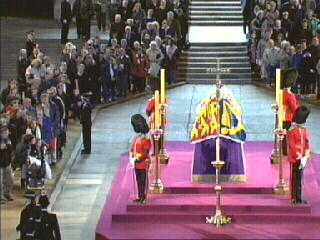

Since the death of Queen Victoria, ceremonial or state funeral processions have been carried out on the death of a British Monarch, a close member of the British Royal Family or, in some cases, a highly regarded statesman or woman. These are probably the most powerful and moving ceremonies of state which take place in Britain. State funerals are normally reserved for the death of the reigning Monarch or can be granted by the Monarch to others.
The coffin is carried on a gun carriage, escorted in a long procession by members of all the armed forces and by members of the Royal Family, to Westminster Hall where the body lies in state, allowing ordinary people to pay their last respects by filing past the coffin.
The practice of allowing the body to lie-in-state goes a very long way back in history. The people who surrounded the body, be they soldiers or relatives of the deceased sovereign, were essentially representing the feelings of the people and ordinary people were therefore allowed to see the body lying-in-state in order to bond the people and the Nation together.
The processional ceremony,however, is relatively recent in origin, beginning only with the death of Queen Victoria in 1901 and continuing with the funeral of Edward VII. The processional route including the Mall was only remodelled or, in the case of Admiralty Arch, constructed between 1906 and 1913.

In the modern procession the gun carriage is formed from a detachment from The Kings Troop, Royal Horse Artillery. However, during a state funeral, the gun carriage would be drawn by members of the Royal Navy rather than artillery horses. The origin of this custom being that, during the procession at the death of Queen Victoria in 1901, the horses pulling the gun carriage bolted and naval ratings had to drag the carriage to the Royal Chapel at Windsor.

The Bearer Party carry the coffin towards the gun carriage before the procession begins and carefully place it on the prepared carriage.
The Garrison Sergeant Major first gives the order to the procession to reverse arms and then to slow march

and the procession moves off to the beat of the muffled drums of the bands which play funereal music. The gun carriage is followed by members of the Royal Family, walking behind, along with other dignitaries and members of the Royal Household.

During the procession, guns are fired from Hyde Park at one minute intervals.
 |
 |
The funeral procession, which is usually more than half a mile long, continues on its way towards Westminster.

The funeral procession passes through the Horse Guards Arch, which was once the main gateway to Buckingham Palace, before turning right onto Whitehall

and proceeds along Whitehall towards Westminster Hall

On arrival, the bearer party remove the coffin from the gun carriage

and carry it into the ancient Hall where the catafalque awaits.

The coffin is borne to the centre of Westminster Hall and placed upon the catafalque where it will remain for several days during the lying-in-state. A short receiving service takes place which is led by the Archbishop of Canterbury attended by dignitaries and members of the Royal Family.

As the final prayer ends, the first vigil begins. In a tribute evocative of Arthurian legend, four officers march down the steps of the Hall, past the heraldic beasts, across the stone floor and mount the catafalque, one at each corner of the coffin. The coffin is guarded in this way, during the lying-in-state, by officers from Household Division, The Queen's Bodyguard of the Yeomen of the Guard, Her Majesty's Bodyguard of the Honourable Corps of Gentlemen at Arms and The Royal Company of Archers in turn and turn about.

They reverse their ceremonial weapons, resting their hands upon the hilts and bowing their heads. Each unit mounts guard for six hours at a time with the guard being changed at twenty minute intervals.

The body lies-in-state in order to allow time for ordinary people to file past and pay their last respects.
The funeral service then takes place in Westminster Abbey or St Paul's Cathedral.
Westminster
Hall, one of
the few ancient parts of the Palace of Westminster to be
preserved after it was rebuilt in the 19th century, is
one of the most historic buildings in Europe. It owes its
present dimensions to William Rufus, William the
Conqueror's second son and his successor. The strain
that this undertaking put on the king's masons can be
seen from a serious mistake that they made in aligning
the columns and buttresses. Those on the west side are
4ft adrift from those on the east. In time, Westminster Hall would be the court in which sentences were passed on the pretender Perkin Warbeck; Henry VIII's chancellor, Sir Thomas More; Protector Somerset, the Duke who ruled England during part of Edward VI's minority; and Guy Fawkes, of the Gunpowder Plot. The greatest of all state trials took place here in 1649 when Charles I was condemned to be beheaded. Later, fashionable society flocked there for the trial of George IV's wife, Queen Caroline, for adultery. It is in Westminster Hall that British monarchs since Edward VII have lain in state, the last lying-in-state being that of Queen Elizabeth II in September 2022. |
Website design and management by: TurnipNet
e-mail : ceremony@trooping-the-colour.co.uk
Please note: This
is not an official website. Please check official sources for up
to date information about military events.
The HQ London District official webpage is at: www.householddivision.org.uk